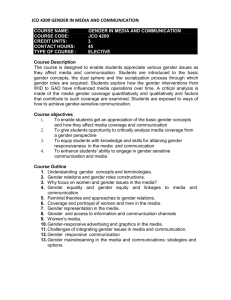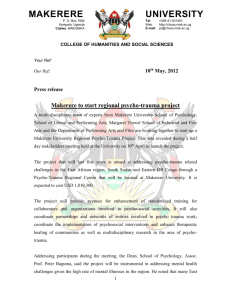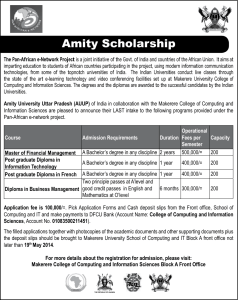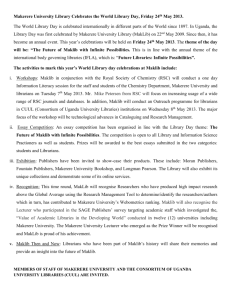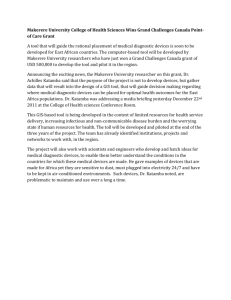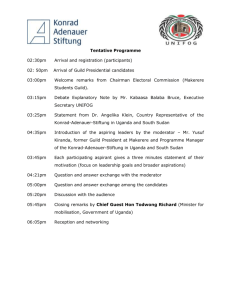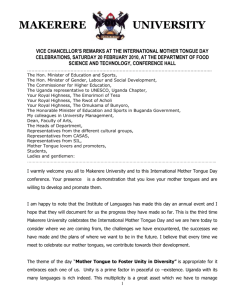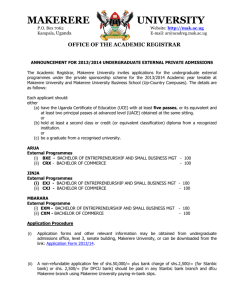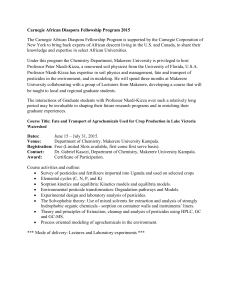The-Chancellor-Prof-Kagonyera-Address-6th-SARChI
advertisement
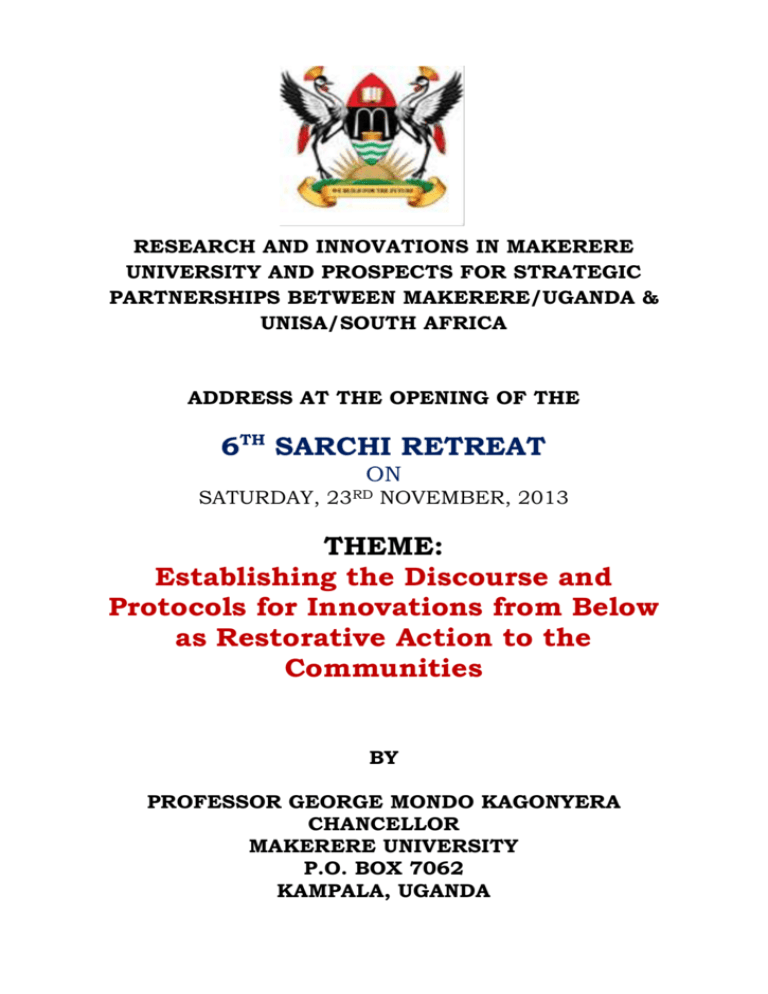
RESEARCH AND INNOVATIONS IN MAKERERE UNIVERSITY AND PROSPECTS FOR STRATEGIC PARTNERSHIPS BETWEEN MAKERERE/UGANDA & UNISA/SOUTH AFRICA ADDRESS AT THE OPENING OF THE 6TH SARCHI RETREAT ON SATURDAY, 23RD NOVEMBER, 2013 THEME: Establishing the Discourse and Protocols for Innovations from Below as Restorative Action to the Communities BY PROFESSOR GEORGE MONDO KAGONYERA CHANCELLOR MAKERERE UNIVERSITY P.O. BOX 7062 KAMPALA, UGANDA Professor MandlaMakhanya, Principal and Vice Chancellor, UNISA; All UNISA leaders and officials in your various capacities; Leaders and officials of the Department of Science and Technology (DST) of the South African Government; All other Chancellors and Vice Chancellors here present Professor Catherine Alum Odora Hoppers, DST/NRF SARCHI Chair in Development Education in UNISA; Distinguished Fellows of the SARCHI Chair in Development Education in UNISA; Distinguished Elders of the IKS Advisory Faculty of the SARCHI Chair in Development Education in UNISA Brothers and Sisters: 1.0 INTRODUCTION It gives me great joy and pride to be here with you today for the 6th SARCHI Retreat on “Establishing the Discourse and Protocols for innovations from below as Restorative Action to the Communities.” May I first of all thank you all, the people and Government of South Africa in general; and the Vice Chancellor and community of UNISA in particular? Thank you for giving a home away from home to our distinguished daughter of Uganda, Professor Catherine Alum Odora Hoppers! Although her cultural tap roots are in Gulu, Northern Uganda; her philosophical main stem has grown strong and tall like the giant Shea-nut tree (of her native Acholiland) in South Africa. Her intellectual and scholarly productions, like her Shea-nut tree branches, have now spread out and cover the whole of Africa. Meanwhile her knowledge productions--like the Shea-nut oil—now oil and lubricate a new Epistemology of Hope and Healing! It is a balm of healing that drips and flows for the healing of Africa and Humanity right from here in UNISA and South Africa! Thank you, South Africa. Thank you, UNISA. You have looked after our daughter and sister, Catherine Alum, very well! 2.0 MAKERERE UNIVERSITY: HISTORICAL BACKGROUND Our Sister Catherine’s invitation stated that I will be expected to give a 1520minutes address to the 6thSARCHI Retreat on behalf of Makerere University on the theme: “Research and Innovations in Makerere University and prospects for strategic partnership and collaboration between Makerere University/Uganda and UNISA/South Africa”. First a brief historical background to Makerere University: Page | 2 Makerere University began as a small technical institute in 1922 with 14 students as day boys, 4 instructors as Academic Staff, in temporary buildings. From this humble beginning, Makerere grew to become one of Africa’s leading Universities. Initially established to meet the high demand for native artisans in the East African territories of Uganda, Kenya, and Tanganyika and beyond; Makerere quickly gained a reputation in the territories for producing quality Artisans, School teachers, Medical, Veterinary, Agricultural and other Administrative Staff in support of the Colonial Administrations in these territories. In a step wise manner over the years, Makerere became a College of the University of London, a College of the University of East Africa and in 1970—anindependent National University of Uganda through an Act of Parliament. We have just concluded the Grand Finale of the one-year celebrations of Makerere’s 90 years of existence (1922-2012), dubbed Mak@90, this past August 03rd 2013. Makerere has produced nationalist and pan-African leaders who led their East and Central African countries to independence. Many other Makerere Alumni have also been instrumental in post-Independence nation building of their countries. Such Alumni include late Mwalimu Julius Nyerere of Tanzania; late Apolo Milton Obote of Uganda; late JaramogiOgingaOdinga, Kenya’s foremost nationalist and anti-colonial fighter who became his country’s first post-independent Vice President; just retired Kenyan PresidentMwaiKibaki; and former Tanzanian President Benjamin Mkapa. DRC’s President Joseph Kabila and his twin sister Hon Jeannette Kabila also attended Makerere University. 3.0 “GLORY YEARS” OF THE 1950S AND 1960S FOR MAKERERE UNIVERSITY MEDICAL SCHOOL Makerere was a leader in Africa in ground breaking and world-class research, especially in its Medical School. According to Carol Sicherman’s book, Becoming an African University: Makerere 1922-2000, Kampala: Fountain Publishers, 2006, page 153: Until the collapse of the 1970s, Makerere/Mulago produced some of the most significant research conducted in Africa…The best known of such diseases studied at Makerere, Burkhitt’s lymphoma, was one of many medical conditions elucidated by Makerere researchers; another was endomycardial fibrosis, sometimes called Davies’ Disease after J.N. P Davies, the Professor of Pathology who began publishing on it in 1948…From the late 1940s through the 1960s, Makerere’s doctors studied cancer and heart disease, ailments previously thought of as “diseases of civilization’ from which Africans seldom suffered”. Cook was the progenitor of cancer research in Uganda…. In 1954, he established the first Cancer Registry in tropical Africa Page | 3 3.1 Dr Krishna Somers: Makerere’s historical Partnership with South Africa Uganda owes a debt of gratitude to South Africa for Makerere’s “Glory Years” of the 1950s and 1960s. The first example is Dr Krishna Somers and his exceptional success in Cardiology research in Makerere Medical School from 1957. According to Carol Sicherman’s “Becoming an African University…” page 154: Cardiology research took place in two units within the Department of Medicine, both entirely dependent on external funding…Until the Research Unit fell victim to Amin [regime] and was transferred to Ghana, researchers collaborated with colleagues in the departments of Pathology and Preventive Medicine…Originating as a treatment focusing on hypertension, the Cardiac Clinic was founded in 1958 with a single doctor, Krishna Somers, a South African who had come to Makerere in 1957 after completing postgraduate training in London. Somers returned from a fellowship at the University of California-Bekerley to found a modern investigative laboratory that provided “the only (cardiac) diagnostic service in the whole of English speaking middle Africa”…In addition, it conducted research, mainly on endomyocardial fibrosis; Somers also collaborated with the Professor of Pharmacology, Sultan Karim, on his pioneering research on prostaglandins….The cardiologists collaborated with other departments in the Medical School and the Faculty of Science, as well as with colleagues in the UK, the US, Ibadan, Brazil and Barbados. South Africa also gave Makerere Medical School an early model and experience of Community Public Health, which took into account traditional and cultural values of the local community. This was implemented in Kasangati north of Kampala City, as described below. 3.2 Kasangati: Best Practice in Social Medicinefrom Natal, South Africa According to Sicherman: At the Kasangati Health Center, nine miles north of Kampala, medical students learned that a clinician and a rural public health doctor…had to be sensitive to local beliefs and traditional practices in order to practice Western medicine. The development of the 18-square mile Kasangati area as a laboratory of community medicine and new pedagogy was an outgrowth of Dean Alexander Galloway’s familiarity with “modern thinking on the place of preventive medicine and human ecology in medical education”…Galloway was a Scot who had taught at the University of the Witwatersrand 1932-46, Page | 4 where he encountered advanced South African thinking about social medicine; he later recruited some of the leaders to Makerere…[page 156-7] I am privileged as only the 2nd Non-Head of State Chancellor of Makerere University, to stand in-front of this august UNISA audience and say that we are grateful for the best practice in Social Medicine that we received from South Africa more than 50 years ago. How was this so? The answer is that: Kasangati arose in 1959 as a joint project of the Makerere Department of Preventive Medicine and the Buganda Government....Its origins went back to discussions in 1950 with the London School of Hygiene and Tropical Medicine…Some years later, Galloway recruited George W. Gale and F. John Bennett, who had both worked at an influential pilot project in South Africa, the Pholela Health Center in Natal, started in 1940 and remarkably successful until the National Party came into power in 1948. As UNICEF Professor of Preventive Medicine (1955-60), Gale advocated the “unique marriage of public health and clinical care” pioneered and embodied at Pholela. It was his idea to transform the Kasangati dispensary into a clinic where Makerere students would learn social medicine. Kasangati was Pholela reborn, albeit in different and more challenging circumstances…Bennett consulted Sidney Kark, the founder of Pholela, then teaching in Israel; Kark visited Kasangati for three months in 1964. The first new hire, in 1960, was Langford Letlhaku, a South African health educator with experience in similar centers in his native country, whose job was to link Kasangati with the community, other agencies, and Makerere students. With all the foregoing, you will appreciate what Professor Ali A. Mazrui, one of Makerere’s famous Professors of Political Science during the 1960s, who said as follows: “had Idi Amin’s coup of 1971 delayed by two or three years; Makerere Medical School would have won the Nobel Prize in Medicine for its path-breaking research in Tropical Medicine”!This was during Mazrui’s Public Lecture in the Makerere Main Hall in 2006 to mark the 40th Anniversary of the Central Bank of Uganda. 4.0 “GLORY YEARS”AND OTHER MAKERERE FACULTIES Three other programs of Makerere’s “Glory Years” illustrate some of the challenges amidst success. These were the Departments of History, Religious Studies & Philosophy and the East African Institute of Social Research (EAISR) 4.1 Department of History In 1950, Roland Oliver then a Historian in the School of Oriental and African Studies (SOAS), London, recommended Makerere to hire Page | 5 one or two African Lecturers to edit vernacular manuscripts on historical subjects and help with the collection and preservation of the wealth of historical knowledge which is still in oral state. The “all-white membership” of the academic board was unreceptive to his suggestion, and the Department of History did not undertake serious Africanization of staff and curriculum for another dozen years. In 1950-51, Kenneth Ingham and D. Anthony Low…came to resuscitate History…They believed that historians must depend on written sources, which…were by colonialists. Ingham eventually began to wonder about African voices: “What of the opinions and reactions of the discovered, of the conquered, of the proselytized and the governed?[Sicherman, page 90.] Not surprisingly, it was the History Department in Makerere University of the “Glory Years” of the 1950s and 1960s that witnessed the racial struggle between the study of African History from “oral sources” or “History” as the colonial story. It was to be the African Students who rose up for the defense of the study of African History from Oral Sources. According to Sicherman: …Makerere students disputed Ingham’s dismissal of oral sources as “largely a matter of legend”, useful to anthropologists but not historians. In 1950, Bethwell Alan Ogot won the Arts Research Prize with an essay based on primary research among Luo elders…When Ogotproceeded to SOAS for his PhD under Oliver, his decision to study East African precolonial history earned him ridicule from his “friends and mentors”. “Where”, they wanted to know, “are the documents?” Ogot and Oliver realized that oral-based history would be at once a “methodological breakthrough” and a “high risk venture”.[Page 90] However, it was the hiring of more African Staff that became one of the three most important catalysts to the Africanization of Makerere’s History Department, as Sicherman observed: Even though R.W Beachey, Ingham’s successor as Chair, was unsympathetic to oral history, he nonetheless hired key African staff— Ogot, M.S.M Kiwanuka, PharesMutibwa, and two foreigners who contributed significantly to the new historiography—Godfrey N. Uzoigwe (a Nigerian) and Donald Denoon (a South African)…Other Africans joined the department, among them several Nigerians escaping from the Biafran war…Moving to Nairobi in 1964, Ogot declared war on he “racists who were determined to deny Africa any historical past.[Page 90] Once again, in Donald Denoon, we had South African solidarity in the Department of History during Makerere’s “Glory Years”. Page | 6 4.2 Department of Religious Studies and Philosophy It may come as surprise to many that it was Makerere University of the “Glory Years” that was the birth-place of the academic study of African Traditional Religionsin East Africa.It was in 1968 when the Kenyan Rev Dr John Mbitibecame Professor and Head of Department of Religious Studies and Philosophy. And the following year, 1969, he published his seminal book, African Religions and Philosophy, [which] was the first work to significantly challenge Christian assumptions that traditional African religious ideas were "demonic and anti-Christian". His sympathetic treatment of traditional religions was based on massive field work. Mbiti is clear that his interpretation of these religions is from a firmly Christian perspective, and this aspect of his work has sometimes been severely criticized [Wikipedia, the free encyclopedia] In a very important commentary about Makerere’s contribution to the study of African Traditional Religions, albeit with a Christian bias, Carol Sicherman observed: The research produced by Religious Studies during the 1960s falls into two categories: books by King, Mbiti and others that helped create the field…The foundational publications reverberate today. In the African Concept of Time (2000), Ernest K. Beyaraza, a Makerere philosopher, rebutted Mbiti’s famous thesis that traditional African concepts of time included the past and present, but not the future and that, without a concept of the future, there could be no progress in the modern sense. Through a case study of the Bakiga, Beyaraza overthrew a “father” of African philosophy. With knowledge of European and indigenous thought systems, the book manifests the kind of “African” thought dreamed of in the Glory Years.[Page 95] 4.3 East African Institute of Social Research (EAISR). According to Professor DharamGhai’s Memories of Makerere’s Golden Years: As an academic institution, Makerere boasted of high standards. Entry to Makerere was fiercely competitive. The faculty was largely expatriate with most staff members drawn from British Universities. The graduating students were awarded London University degrees, which also reviewed the course content and examination papers and students’ grades….the East African Institute of Social Research was a leader in Africa on anthropological and sociological research….Many gifted graduate students came from abroad to work on their doctorates for prestigious universities….[DharamGhai, Memories of Makerere’s Golden Years, 2008] Page | 7 5.0 THE DECLINE OF MAKERERE: 1970S AND 1980S It is sad but true that Makerere’s “Glory Years” came to an end with the onset of Idi Amin’s military regime in 1971. The upheavals that bedevilled Uganda since and for over two decades following did not spare Makerere University. The Vice Chancellor, late Frank Kalimuzo, was abducted and assassinated by state agents in 1972. This formed the backdropof Makerere’s Golden Jubilee, 1922-1972! Because of widespread insecurity and subsequent civil wars, there was an exodus of Makerere’s academic staff out of Uganda. Many of these were hired by other universities in the East African region, other parts of Africa, as well as internationally. The economic collapse and the civil wars resulted in deterioration of learning and teaching conditions and a massive brain drain out of Uganda. But a small remnant soldiered on. I first returned to Makerere as a Lecturer after my Master of Science (MS) degree from the USA in 1971. This was when I started the Department of Veterinary Clinical Studies with the help of Dr Murray Fowler of the University of California at Davies. Then I went back to the same University and completed my PhD and returned to Makerere University in1986 when I became Associate Professor and Dean of the School of Veterinary Medicine. I, too, could have also run; but I chose to stay and make my humble contributions to keeping Makerere going. It was not easy. 6.0 A NEW RESURGENCE IN MAKERERE UNIVERSITY But since the 1990s, a new resurgence has been taking place in Makerere University, following the liberalization of Higher Education in Uganda. Student enrolment has risen from 2000 to 40,000 over a ten year period, 1990-2000. Out of these: 6,000 are Government sponsored and 34,000 are privately sponsored students. The number of new universities in Uganda has also increased from one (Makerere) to 7 Public universities and over 20 private universities. Makerere University has again taken the mantle of world-class leadership in Research, especially in HIV/AIDS research by the College of Health Sciences (CHS); innovation, incubations and commercialization in the College of Agricultural and Environmental Sciences (CAES) and the College of Engineering, Design Art and Technology (CEDAT); College of Veterinary Medicine, Animal Sciences and Bio-Security (CoVAB); and the College of Computing and Information Sciences (CoCIS). 6.1 Page | 8 Presidential Innovations Initiative in Science, Technology and H.E President Yoweri Museveni is an ardent promoter of Indigenous Knowledge Systems and Science, Technology and Innovations (IKSSTI). Below are some of the examples: Way back in the 1990s, President Musevenisponsored commercial manufacture of toothpaste from Ugandan indigenous lemon grass (lutete). President Museveniis an ardent promoter of African languages; and together with Makerere University Academics of Linguistics, he has produced a Runyakole-Rukiga Dictionary. He is also in the forefront of encouraging research in herbal medicines and preservation of African indigenous crop varieties; and promotion of indigenous foods. Recently, President Museveni has been promoting cakes made out of “millet”. Furthermore, for President Museveni: modern Science, Technology and Innovations in Africa must be built on the foundation laid by African Indigenous Knowledge System (IKS), Science and Culture. This is why in 2010, President Museveni directed Government to allocateMakerere University Uganda Shillings 25 billion (about $ 8million) for Science, Technology and Innovations for 5 years up to 2015. This made it possible for Makerere students and staff to produce Uganda’s first designed and built electric car--the Kiira EV Car! Thanks to the success of the Kiira EV Car, Makerere University’s College of Engineering has developed the Center for Research in Transport Technologies (CRTT) focusing on renewable energy and transport technologies is to incubate and commercialize the Kiira EV Car and other innovations under the Presidential Initiative in STI in the College of Engineering. Once again, through President Museveni’s leadership, Government has “ring fenced” Uganda Shillings 154 billion (about US 50million) for the next 10 years for the CRTT. 6.2 Innovations and Incubations in the College of Agricultural Sciences Under the Presidential Initiative in STI, Makerere has acquired a mobile fruit juice processor for juice processing for farmers, women and youth groups in the rural areas. It is in the School of Food Technology, Nutrition and Bio-Engineering in the College of Agricultural and Environmental Sciences, CAES. Page | 9 It recently processed over 100tons of mango juice every week from May 16 to June 20, 2013, in Yumbe District in Northern Uganda close to the Southern Sudan border. As a result, Makerere Professors of Agriculture were able to estimate that Yumbe District alone could have an economy worth Uganda Shillings 140 billion (over $48million) per annum with efficient value-addition and marketing. Furthermore, Makerere’s College of Agriculture has also invented a handheld portable Nitrogen Soil Tester. Soil Scientists and Farmers can use it on their farms, especially in the rural areas; without having to transport soil samples back and forth to laboratories in the City. It is prized at $100 each. Ghana’s Ministry of Agriculture has expressed interest in importing over 10,000 of the Soil testers; and Mozambique and Rwanda’s Ministries of Agriculture have similarly expressed interest in the soil tester. 6.3 Indigenous Knowledge Systems (IKS) Research Makerere is involved in IKS research in various colleges and units but lacks coordination and coherence. However, Makerere needs an underpinning conceptual premise and overarching framework to fully harness our IKS research towards incubation and product development. This will enable Makerere to mainstream IKS research within the Science, Technology and Innovations paradigm, which currently is enjoying funding support from the Government. It will also impact on the policy arena in Government and possibly link well with similar IKS research and knowledge productions in the Ministry of Health, Ministry of Agriculture, Ministry of Education and Sports, Ministry of Tourism, Ministry of Gender, Culture, Labor and Social Development, etc. Let me cite four examples in 4 Colleges: In the College of Health Sciences, CHS; Professor Jasper OgwalOkeng, Head of the Pharmacology Department won a $100,000 three year Grand Challenges Explorations Grant from the Bill and Melinda Gates Foundation to “test whether insect-eating plants can reduce the population of malaria transmitting mosquitoes and their larvae” In the College of Agricultural and Environmental Sciences, CAES; Professor John Tabuti, an Ethnobotanist, in the School of Environmental Sciences; is carrying out research aimed at developing a herbal drug to treat HIV/AIDS. The three year project is titled, “Value chain analysis and development of plant derived medicinal products for management of HIV/AIDS in the face of climate change”. It is being supported by the Swedish International Development Cooperation Agency and is implemented by the Inter University Page | 10 Council for East Africa through the Lake Victoria Basin Research Initiative. In the College of Humanities and Social Sciences, CHUSS; the Department of Literature in collaboration with the Department of Foreign Languages at the University of Bergen in Norway launched a book on folktales of Uganda. The book was co-edited by Rev Sr. Dr. Dominic Dipio, Associate Professor of Literature in Makerere University, and Prof Stuart Sillars of the University of Bergen. The 276-page book is titled, Traditional Wisdom: Folktales from Uganda, and is a collection of 100 folktales from diverse cultures in Uganda and a ‘gem for enthusiasts of Cultural studies, Scholars of Orature and folklore as well as lovers of stories. The book is the result of research carried out on the folklores of the people of Uganda in a project that started in 2007. The main objective of the project, according to Sr. Dr.Dipio, was to document and disseminate the richly imaginative cultural forms of Ugandan peopleusing a multi-media approach. The Department of Biological Sciences, School of Bio-Sciences in the College of Natural Sciences, CoNAS; is involved in research, training and community outreach in resource conservation and benefit sharing. It has also undertaken research with local communities on various aspects of medicinal plants used in traditional medicine, including conservation and natural products development. The Departmentwill be hosting the 15th Congress of the International Society of Ethnobiology in 2016.The contact person is DrEsezaKakudidi and some of the Congress’ sub-themes include: Indigenous Knowledge Systems and Food Security; Traditional Medicine, Spirituality and the Law; Traditional Medicine and Modern Medicine: bridging the gap between the two. 6.4 Academia-Industry/Private Sector Interface In 2006, Makerere University’s Council established the Makerere University Private Sector Forum, MUPSF, as an interface for knowledge transfer and partnerships between Academia, the Private and Public Sectors physically located on the Main Campus. It is headed by a Board of Trustees chaired by Professor Emmanuel Tumusiime-Mutebile, Governor of the Bank of Uganda, and an outstanding Makerere Alumnus who was also a Student Guild President in the 1970s. He was recently voted the “best Central Bank Governor in Africa” by the World Bank/IMF Investors Round Table in Washington DC. Page | 11 Among its landmark achievements, MUPSF has innovated the recognition and honour of five (5) outstanding Ugandan Private and Public Sectors leaders and achievers as Honorary Professors of Makerere University. It has also conceived several Endowed Chairs in the pipeline in perpetual recognition of Professor Ali A Mazrui; H.E MwaiKibaki, former President of Kenya and outstanding alumnus, and Professor Emmanuel TumusiimeMutebile, etc. However, Makerere’s resurgence and explosive growth have come with challenges. Infrastructure and Staff numbers have not kept pace with the explosion in Student Population. Financing arrangements have not been optimal--especially competitive salaries for Staff. Governance challenges have complicated the situation further. Thus resurgent Makererehas also witnessed several staff strikes in the recent past. It was partly to address the Staff Strike of September 2011, and the chronic instability of Makerere that Government set up the Task Force on Job evaluation, Re-organization of Staff Structure and Financing of Makerere University, chaired by Professor Francis G. Omaswa, who attended the 5th SARCHI Retreat last year. It was inaugurated by the Rt Hon AmamaMbabazi on 18th November 2011 and, after two years of work; willbe submitting its report to the Prime Minister/Government this coming Tuesday, 26th November 2013. 7.0 BECOMING AN AFRICAN UNIVERSITY From all the foregoing, I hope you can see that much as Makerere has glittered in its heyday, declined, and has now begun resurgence: Makerere has been located in Africa but oriented outwards--not to the rest of Africa-but Europe and America. Carol Sicherman’sEpilogue, “Toward an Afrocentric Gold Standard” in her book I have quoted extensively here makes the following observations that I will use to conclude my address: The Prologue to this book questions whether Makerere is a university of Africa, or simply in Africa. The question remains. Despite jokes about the “Ivory Tower” becoming an “Ebony Tower”, the word “becoming” in the title of this book—endorsed by many of the Makerere staff with whom I spoke--implies that Makerere is only partly an African University, just as “Uganda” represents a postcolonial nation still in the process of formation. Still, there has been some progress on the road to “becoming”….Creation of Afrocentric gold standard also requires looking outward—not to the entire world but to the continent, in order to involve other African universities wishing to liberate themselves from dependency on foreign money and foreign ideas. A standard derived from African needs and possibilities could do much to stanch the brain drain stemming not only from inadequate conditions of work and pay Page | 12 but also from a “mismatch” between specialized training acquired abroad and the home academic circumstances”. I was thus impressed with the Concept Note for this 6th SARCHI Retreat which my sister, Professor Catherine Alum Odora Hoppers, sent me. I especially like UNISA’s strategic vision as an African University expressed as follows:- As a major continental and global player, and seven years into its new identity as a comprehensive university, UNISA’s commitment to its tone-setting vision of being THE African university in the service of humanity enables us to explore key codes by which we can reinvigorate our goals, our strategies, and the values that should underpin all our actions. The question is: can UNISA lead the way so that the transformation of South Africa’s higher education and science systems becomes part of the broader Third World process of political, social and economic transition, which includes political democratisation, innovation and economic reconstruction and development? 8.0 CONCLUSION: MAKERERE/UGANDA AND UNISA/SOUTH AFRICA PARTNERSHIPS In conclusion, may I propose the following areas for further discussions between the leadership of Makerere University on behalf of Uganda; and UNISA on behalf of South Africa? 8.1 UNISA/SOUTH AFRICA-MAKERERE/UGANDA PARTNERSHIP I therefore propose as follows:8.1.1 Together we develop terms of reference (TORs) for strategic partnership and collaborations between Makerere University with its various constituents and UNISA with its various constituents through the SARCHI Chair in Development Education. This would be spearheaded and led by the incumbent SARCHI Chair in Development Education in UNISA: our distinguished sister, Professor Catherine Alum Odora Hoppers! 8.1.2 That the DST/Government of South Africa be part of this discussionin acknowledgement of the fact that both the SARCHI Chair in Development Education in UNISA and the Incumbent, Professor Catherine Alum Odora Hoppers; are supported by South Africa’s Department of Science and Technology (DST) through the National Research Foundation; may I suggest. Page | 13 8.1.3 Thus, Makerere University too will endeavor to bring strategic Agencies and Sectors of Uganda Government on board, especially in promotion of Indigenous Knowledge Systems (IKS) and in promotion and scaling up the Presidential Initiative in Science, Technology and Innovations in Makerere University and in Uganda as a whole. 8.2 SOUTH AFRICA PRIVATE SECTOR/BUSINESS INVESTMENT IN MAKERERE UNIVERSITY I have the honor to propose as follows:8.2.1 That UNISA’s leadership and the SARCHI Chair in Development Education invites and brings on boardSouth African Business/Private Sector, in particular, such South African businesses and companies as Eskom, MTN, Standard Bank, Protea Hotels and Shoprite, etc., which have significant investments and presence in Uganda. UNISA should be effective to invite and encourage such South African businesses and companies to support some infrastructure developments in Makerere University, especially in exercise of their Corporate Social Responsibility(CSR) in Uganda. 8.2.2 That UNISA, in particular, invite and encourage these companies to contribute to the development of a state-of-the-art Makerere University Press out of the existing Makerere Printery and Bookshop we have; with UNISA providing capacity building and technical backstopping towards the development of a state-of-the-art Makerere University Press. Makerere has the land for scaling-up the existing Printery and Bookshop infrastructure to a modern University Press. But why ask UNISA to encourage these South African Companies from here? In true African IKS wisdom: you start climbing a tree from the bottom, not from the branches! Now UNISA is at the bottom or roots of these companies; we in Uganda are the branches! 8.2.3 That such a strategic partnership and collaboration, such a South African company like Protea Hotel could seize the investment opportunities in Makerere University as Makerere owns some of the most prime land and real estate in Kampala and other parts of the country. I am confident that Makerere University Council will be interested to discuss prospects for Protea Hotels investing in the current University Guest House. I am aware Makerere’s Directorate of Investment has developed a business planto expand and rebuild the existing Makerere Guest House into a 4-star or 5-star Hotel. Page | 14 Here is an opportunity for UNISA to invite and encourage Protea Hotels, for example, to seize this investment opportunity in addition to the Protea Hotels in Entebbe, Mbale and Kampala. 8.2.4 On Makerere’s side, the Makerere University Private Sector Forum (MUPSF) could facilitate such investment opportunities. On UNISA’s side, perhaps the Graduate School of Business and Leadership could network with the South African companies through the SARCHI Chair in Development Education. This could also be in partnership with MUPSF and also include business, management and leadership research collaboration withMakerere’sCollege of Business and Management Sciences (CoBAMS). 8.3 INVITATION TO SARCHI CHAIR IN DEVELOPMENT EDUCATION IN UNISA TO LEAD A DELEGATION TO MAKERERE/UGANDA As a concrete way forward: may I propose that a delegation led by the SARCHI Chair in Development Education comprising UNISA leaders, DST Officials and IKS Advisory Faculty leaders, and South African Private Sector/Business leaders plan to visit Makerere University and Uganda as soon as is practicable? I THANK YOU. Page | 15
